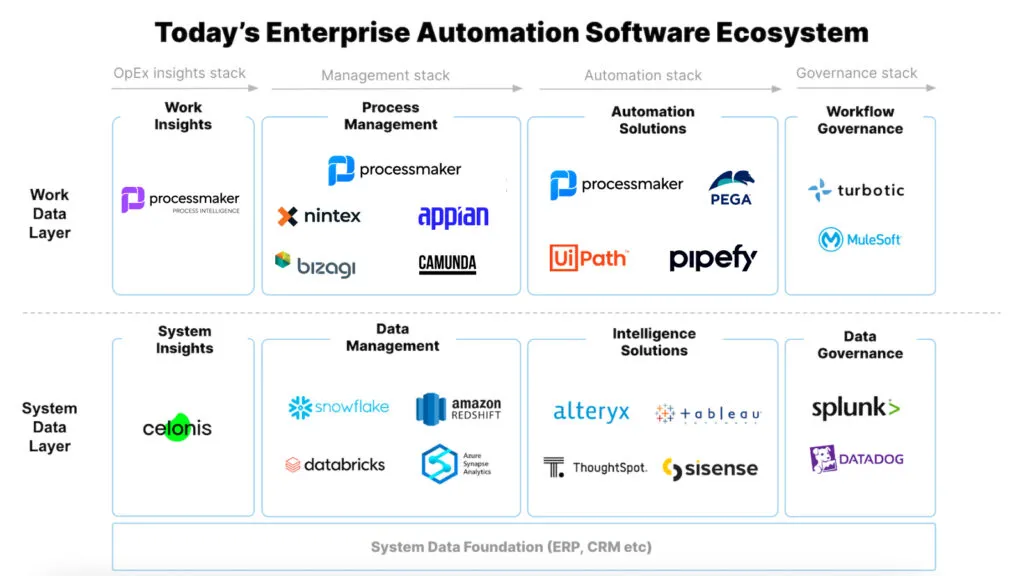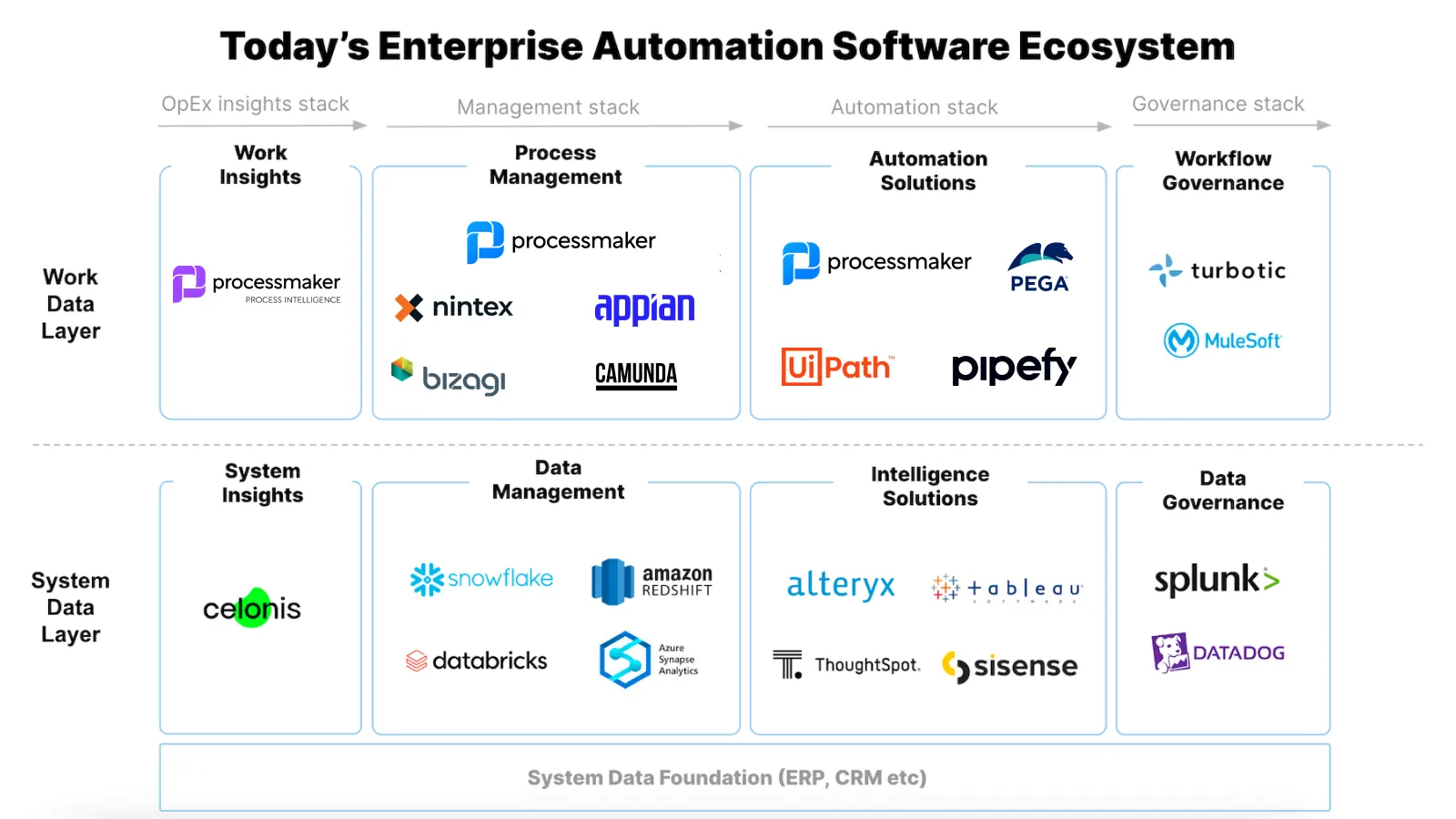Enterprise automation: what, why and how in 2024
Blog: Blog | ProcessMaker
Automation has become a crucial component of business operations, significantly transforming practices across diverse industries. Organizations are not only automating routine administrative tasks but also tackling more complex decision-making processes.
However, this is merely the beginning of the journey. According to research from Goldman Sachs, up to 25% of all work could potentially be automated with the aid of generative AI. In this article, we will explore enterprise automation and its role in streamlining operations and enhancing productivity.
What is enterprise automation?
Enterprise automation can be described as the use of software and technologies such as robotic process automation (RPA), artificial intelligence (AI), machine learning (ML), etc. to comprehensively automate business processes.
An enterprise automation platform is crucial for integrating these technologies and ensuring seamless automation across various business functions. The said technologies can help improve strategic decision-making, reduce manual work, decrease errors, and increase work efficiency. Enterprise automation can be leveraged in any unit and function and is not limited to a specific industry.

Enterprise automation software landscape
How to build an enterprise automation strategy
Enterprise automation path might differ from company to company depending on their size, IT structure, and automation level. However, the overall strategy remains the same and can be summarized as follows:
- Holistically review and discover the business processes in the organization.
- Identify the parts of the business that can be automated.
- Find suitable automation technologies for each process.
- Build a roadmap for the implementation of automation activities.
- Manage automation initiatives on an employee level.
- Follow up on the automation activities and evaluate their effectiveness.
Assessing business processes for automation
Assessing business processes for automation is a crucial step in implementing enterprise automation. It involves identifying areas where automation can bring the most value, evaluating the complexity of the processes, and determining the potential return on investment (ROI). Here are some key considerations when assessing business processes for automation:
- Identify manual tasks. Start by pinpointing tasks that are repetitive, time-consuming, and prone to errors. These manual tasks are prime candidates for automation, as they can significantly benefit from increased efficiency and accuracy.
- Evaluate process complexity. Consider the complexity of each process, including the number of steps involved, the number of people participating, and the level of decision-making required. Simpler processes may be easier to automate, while more complex workflows might need advanced automation solutions.
- Determine the potential ROI: Calculate the potential cost savings, productivity gains, and other benefits that automation can bring to each process. This helps prioritize which processes to automate first based on their expected return on investment.
- Consider the impact on employees: Assess how automation will affect employees, including the potential for job displacement. Develop strategies to retrain and upskill employees to ensure they can transition to more value-added roles.
- Evaluate the need for integration: Consider whether the automated process will need to integrate with other systems, applications, or data sources. Ensuring seamless integration is vital for the success of automation initiatives.
By carefully assessing business processes for automation, organizations can identify opportunities to improve efficiency, reduce costs, and enhance customer experience.
Types of enterprise automation
Enterprise automation encompasses a range of techniques, tools, and technologies designed to comprehensively automate organizational processes. It includes various methodologies aimed at streamlining workflows and minimizing manual effort. Consequently, the journey toward enterprise automation varies from one company to another, depending on their current level of automation. Business process automation (BPA), Robotic process automation (RPA), and intelligent automation (IA) are three key types of enterprise automation. Consolidating them, you get Business Orchestration and Automation Technology (BOAT). Let’s explore in more detail:
Business Process Automation (BPA)
BPA includes automation of anything from simple tasks to more complex multi-step workflows. Enterprise automation tools play a crucial role in BPA by automating repetitive tasks and enabling employees to focus on more strategic activities. It’s usually basic low- to no-code automations and simple workarounds introduced by employees to fit their own needs.
An example of the simplest automation for marketing could be using the software to schedule and automatically post social media posts at given times. Multi-step workflow automation for the sales team could include automatic lead outreach across several touchpoints.
Robotic Process Automation (RPA)
RPA is a business automation technology that helps to automate repetitive manual tasks. It has been gaining popularity in the last decade with several big vendors like UIPath entering the market. RPA uses software robots to imitate human actions through pre-programmed scripts. It is usually used for units like customer service, data entry, and other similar larger-volume tasks.
Intelligent Automation (IA)
Intelligent automation is a holistic approach to automating the tasks and processes inside the organization using the power of AI and tools like RPA, and Intelligent Document Processing (IDP) to automate mundane tasks. It is sometimes referred to as hyperautomation – the term that was coined by Gartner.
Business Orchestration and Automation Technology (BOAT)
BOAT is a recently introduced term that marks a notable development in the enterprise automation sector. Its purpose is not only managing processes but also orchestrating them with greater sophistication. It features Embedded AI as a core component and emphasizes an adaptive and user-friendly experience that can adjust to changing business needs.
Benefits of enterprise automation
Enterprise automation comes with a number of benefits, and these are just some of them:
- Improved employee satisfaction. By removing mundane repetitive work, people can do more interesting work and have less boring and routine activities.
- Enriched customer service. Enterprise automation can help improve the customer service by improving response times, increasing consistency and accuracy in service delivery.
- Improved productivity and work effectiveness. When low-value tasks are done by the software, people have more time for higher value activities.
- Reduced errors and improved accuracy. Enterprise automation helps to execute tasks without the risk of human error.
- Cost efficiency. Automating certain activities can lead to time savings, where people focus more on strategic initiatives and spend less time on time-heavy tasks.
Emerging technologies powering enterprise automation
The world of enterprise automation is continuously changing, with emerging technologies making it faster and easier to automate even the most complex workflows. Some of the prominent technologies or methods include:
- Process intelligence: A holistic approach to understanding the processes, workflows, and tasks inside the organization. One of the notable approaches in process intelligence is to use the hybrid tool Work API to get transparency into operations. It combines the capabilities of both process mining and task mining.
- Process mining: A process mapping tool that helps to identify areas for improvement and automation.
- Task mining: A task monitoring tool that gives insights into how employees use the systems and tools.
- RPA: Software robots help to automate manual processes simulating the repetitive activities that employees would otherwise perform themselves.
- Chatbots and voice assistants: NLP-powered technologies that can automate customer service interactions.
Overcoming common challenges
Implementing enterprise automation can be challenging, and organizations often face common obstacles that can hinder the success of their automation projects. Here are some common challenges and strategies for overcoming them:
- Resistance to change: Employees may resist changes to their workflows and processes. To overcome this, communicate the benefits of automation, provide training and support, and involve employees in the automation process. Highlight how automation can reduce repetitive and manual tasks, allowing them to focus on more strategic activities.
- Technical complexity: Automation projects can be technically complex, requiring specialized skills and expertise. To overcome this, partner with experienced vendors, invest in employee training, and consider hiring external experts. This ensures that your team has the necessary knowledge to implement and manage automation solutions effectively.
- Integration challenges: Integrating automated processes with existing systems and applications can be challenging. To overcome this, choose tools that provide pre-built integrations, use APIs and connectors, and invest in integration expertise. Seamless integration is crucial for the smooth operation of automated processes.
- Data quality issues: Poor data quality can hinder the success of automation projects. To overcome this, invest in data quality initiatives, use data validation and cleansing tools, and establish data governance policies. High-quality data is essential for accurate and reliable automated processes.
- Security and compliance: Automation projects must meet security and compliance requirements. To overcome this, ensure that tools and processes meet security and compliance standards, invest in security expertise, and establish governance policies. This helps protect sensitive data and ensures regulatory compliance.
By understanding common challenges and developing strategies to overcome them, organizations can ensure the success of their enterprise automation projects and achieve their goals.
The future of enterprise automation
Organizations are continuing to implement automation solutions, and as such, the future of enterprise automation looks promising. We can expect more innovative tools and technologies to enter the market, which can collectively strengthen how much impact enterprise automation can have on companies. That being said, enterprise automation has been an integral part of most digital transformation activities, enabling companies to improve efficiency, decrease costs, and strengthen decision-making capabilities.
The post Enterprise automation: what, why and how in 2024 appeared first on ProcessMaker.
